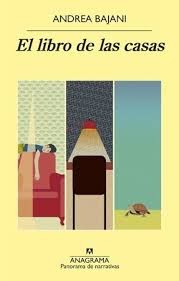
Idioma original: Italian
Original title: The Book of Houses
Translation: Juan Manuel Salmeron Arjona
Year of publication: 2022
Valuation: Highly recommended
As a reader, I always appreciate when an author makes an effort to find his own way to construct a narrative. It is increasingly difficult, because at least in the last century and a half many formulas have been tried with varying degrees of boldness and of course with very different results. Because, of course, experimenting or innovating, which for me is already something appreciable in itself, does not guarantee the success of the formula. There have been many failed attempts, bad imitations or good ideas spoiled by lack of talent or ability to develop them.
We knew Andrea Bajani for Map of an absencea very remarkable novel in which one could distinguish a couple of defining features of his prose. On the one hand, an apparent lack of emotion that is only superficial, because it is almost impossible not to understand that beneath it flow extremely human feelings, perhaps even intense, forming a strange but very attractive contrast between the visible cold and a deep and inevitable warmth. And it was appreciated also the taste for alternating scenarios in apparent disorder, something that, without being groundbreaking, went a little beyond the very usual time jumps or changes of location. Bajani seems to have discovered a path to explore, and in The book of houses He goes on to make a further step, delving deeper into the use of these resources. From child to adult, student, married, lover or solitary, with the grandmother, the irascible father, the mother folded in on herself and her marriage, the erased sister and the excluded relatives, between Rome, Turin, the beach and the snowy Alps, a life passes in which the only stable thing is the old turtle that lives in the courtyard of the family house. A life, which is also the recent history of Italy, in which the images of bodies murdered in the years of lead have been sewn like permanent scars, corpses that we identify with Pier Paolo Pasolini and Aldo Moro.
Once again, Bajani presents, crudely and one might say with resignation, the seemingly insurmountable complexity of family relationships. There is hardly any glimmer of tenderness or complicity, which is quickly destroyed by violence (physical, verbal or silent), by illness or by the simple passage of time that alters everything. The guiding thread is the houses where the events occurred or where nothing happened, houses that are simple dwellings where scenes so brief that they seem almost instantaneous are represented, walls on which only the echoes of what was heard remain and which, once abandoned, return to silence. The house, which is sometimes also a car, a hospital room or a warehouse, has no life of its own, but its furniture speaks its own language or forms vestiges in which the story they lived is recorded.
We therefore have a growing fragmentation (which, admittedly, can sometimes play too much at misleading us) that forms a collection of random images where what matters is the whole, and the almost obsessive objectivity with which Bajani handles it causes us, accustomed to the description of innocuous episodes, to lower our guard and be surprised by those stabs that generate discomfort until they convince us that terrible things are happening.
Illness, violence, submission, loneliness, and detachment filter through this mosaic of almost always harmless scenes, sometimes even pleasant, creating discomfort in the reader who believed he was witnessing a more ordinary story or, even worse, showing how a seemingly normal life (always?) has black spots that, in the best of cases, memory, in defensive mode, can erase.
Source: https://unlibroaldia.blogspot.com/2024/08/andrea-bajani-el-libro-de-las-casas.html


